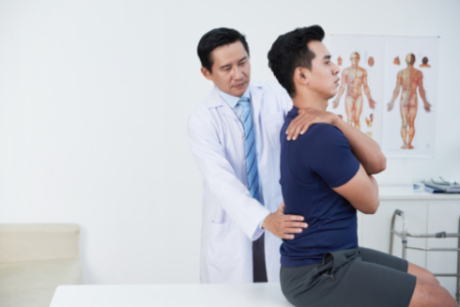7 Ways to Stop and Shorten Sciatica Flare Ups
The last thing you want is another extended bout of sciatica.
Put these 7 tips to use to cut down on and lessen the severity of flare-ups (in order of easiest to do):
1. Take meds (for fast relief).
If you are suffering a sciatica flare-up, you want immediate relief. These meds can help:
- Acetaminophen and NSAIDs: Pain relievers such as Tylenol and Naproxen and non-steroidal anti-inflammatory meds such as ibuprofen and aspirin can provide immediate, short-term relief.
- Muscle relaxers: When the underlying cause of your sciatica is muscle spasms, muscle relaxers such as carisoprodol and cyclobenzaprine can provide relief.
- Tricyclic antidepressants: Doctors prescribe the anti-depressants amitriptyline and nortriptyline to reduce nerve pain. They are prescribed at lower doses than when used for depression.
- Steroids: The oral steroid prednisone provides pain relief by reducing inflammation.
*Please note that all of the above medications have certain side effects. Talk to your doctor before taking them to relieve sciatica.
2. Apply heat and cold.
Applying a cold compress or ice pack to the painful area for 15 to 20 minutes can relieve pain quickly by reducing inflammation.
A heat compress or pack can also relieve pain by increasing circulation and loosening up tight muscles.
3. Don’t sit too much.
Putting pressure on your sciatic nerve for extended periods can lead to sciatic pain. Whether sitting at your desk at work, in a car or plane on a trip, or at a restaurant chatting up friends, remember to get up and walk around for a few minutes now and then.
Also, remember to take your wallet and other objects out of your back pockets when you sit down. They add pressure to the sciatic nerve.
4. Improve your posture.
Poor posture can make sciatic pain worse. When standing and sitting, make sure your back is straight, and your shoulders are back. The idea is to feel tall when standing or sitting.
5. Stretch.
The sciatic nerve runs through your hips, buttocks, and hamstrings. Tight ligaments and muscles in these areas can contribute to sciatic pain.
Stretching these areas keeps the muscles and ligaments loose, which can stop and lessen the pain.
6. Diet and exercise.
Carrying around excess body weight puts added pressure on your sciatic nerve. Dieting can help you shed pounds and maintain a healthy weight.
A non-active lifestyle with a lot of sitting contributes to sciatica. In contrast, an active lifestyle with a lot of movement lessens or even eliminates the pain.
You don’t have to be an Olympic athlete, but incorporating some safe exercise, sports, or outdoor activities into your daily routine can make a big difference.
7. Cut down on stress.
When you are stressed out, your brain supplies less oxygen to your nerves, including the sciatic nerve. Oxygen-starved sciatic nerves are more likely to produce pain.
Visit the Texas Pain Management Specialists
At Texas Pain Physicians, our board-certified pain management doctors know how to manage sciatica. Let us review your unique health situation and develop a pain relief plan that works for you.
Schedule an appointment online today, or give us a call at (972) 636-5727.
5 Ways to Get Rid of Tennis Elbow Pain
Tennis elbow or elbow tendonitis is an overuse injury caused by repetitive activities, such as:
- sports like tennis and racquetball
- exercising and weightlifting
- hands-on jobs such as carpentry and office jobs that involve typing and talking on the phone
- yardwork such as raking and shoveling, and knitting
The main symptom is pain in the bony knob outside your elbow and pain in the upper and lower or forearm. You feel this pain when you use your hands for things like gripping objects and typing.
Here are five easy ways to get some pain relief:
1. Change your routine.
For athletes, this could mean changing up the exercise and or weightlifting routine. Cycle different exercises so that you don’t do the same movement over and over for months.
If a job is causing your tennis elbow, think about how you can change your work area, tools, and habits.
For carpenters, this could mean hiring a helper, using more power tools that don’t require as much hand manipulation, or taking an extra day of rest per week.
For office workers, this could mean trading work tasks and rearranging your work area so that it’s more ergonomic.
2. Get plenty of rest.
Sometimes less is more.
If you are an athlete or play sports often, resting your injured arm is great medicine. Take at least a few days off and allow your elbow tendons to start healing.
Taking time off from work may be harder. For carpenters and other skilled trade workers, this might mean hiring a helper to take some of the physical labor off your plate or taking an extra day off per week.
For paid employees, if you visit your doctor and are diagnosed with elbow tendonitis related to work, you should be able to take time off that doesn’t count against your allotted vacation time.
If you can’t take time off, try to rest your injured arm on your off days.
3. Apply a cold compress.
When your tennis elbow starts, apply an ice pack wrapped in cloth or cold compress as soon as possible for 10 to 15 minutes several times a day. Cold compresses reduce inflammation.
4. Elevate your arm.
Raising and resting your elbow at a level above your heart several times a day will reduce inflammation.
5. Wear a brace.
It’s often not practical to miss practices if you are a full-time athlete or miss workdays when you are a full-time employee. But you can wear a counterforce brace as much as possible.
These special braces reduce the pressure on your elbow muscles and tendons. You can find these online, at pharmacy stores, and in grocery stores in the pharmacy sections.
Tennis Elbow Treatment in Houston, Dallas, and Throughout Texas
At Texas Pain Physicians, our number one priority is to improve the quality of life of our patients. We have helped thousands of people get back to what they need and love to do.
We offer quick access to accurate diagnosis and comprehensive treatment. Call us today at (972) 636-5727 to book an appointment.
Planning Some Outdoor Summer Fun? 5 Injury-Related Tips
According to the CDC, the leading cause of death for people ages 1-44 in the U.S. is unintentional injury.
And during the summer, people of every age group are outdoors and more active.
Here are some tips for preventing and managing common injuries that happen during popular activities.
1. Picnic and Hiking Injuries
Picnicking and hiking are two of the top three favorite summer activities for Americans (according to a 2016 study by the National Recreation and Park Association).
And they account for a significant annual share of visits to the doctor and emergency room for various injuries.
It’s likely someone will suffer an injury like a broken or sprained ankle on a hiking or camping trip. Team sports like dodgeball, volleyball, and softball are popular picnic activities.
Injury Prevention and Management
To reduce the risk of common impact, flesh, and musculoskeletal injuries, use standard safety equipment, observe and enforce safety rules, and warm up with light jogging and stretching beforehand.
On hikes and camping trips far from cars and modern life, pack foldable crutches and walking sticks or canes.
And if there’s extra room, pack a litter or drag. This blanket-like device can be a lifesaver when someone is seriously injured and unable to walk at all.
2. Cycling Injuries
Cyclists, beware.
Traumatic brain injury is a leading cause of death in the United States. Though cycling is popular, helmet laws for cycling are not. And where helmet laws are in effect, many cyclists don’t comply.
Cycling accounts for almost 20% of the sports-related head injuries treated at US hospital emergency rooms in 2018.
The Bicycle Helmet Safety Institute suggests wearing a helmet can reduce the risk of head and neck injury by up to 88%.
Injury Prevention and Management
Concussions can be fatal and have long-term effects, and early evaluation and treatment are critical.
When someone falls from a bike and hits their head, they should seek medical attention as soon as possible. Even when they think they’re ok.
3. Swimming Injuries
Musculoskeletal injuries like swimmer’s shoulder are common in swimming.
Though a much rarer injury than swimmer’s shoulder, diving into the water is one of the leading annual causes of spinal cord injuries.
Injury Prevention
Characterized by inflammation of the shoulder tendons, it develops as swimmers repeatedly raise their arms in a crawl stroke (a stroke people commonly call ‘freestyle’). Varying swimming styles can help prevent swimmer’s shoulder.
To prevent injuries from diving, always supervise children and verify that water depth is a minimum of eight feet.
4. Water Sports Injuries
Riding on boats and jet skis can be thrilling but also dangerous. Common watercraft injuries include:
Brain trauma from oxygen deprivation from being underwater too long and from impact from a collision with another boat or watercraft.
Spinal cord injuries from impact during boat and jet ski collisions and hitting fixed objects.
Spinal compression from absorbing the impact of watercraft bouncing on waves.
Whiplash from impacts during boat accidents.
- Injury Prevention To lessen the chances of injury while operating a watercraft, use all required safety gear, including life jackets and helmets, and follow all relevant maritime laws at all times.
5. Playground Injuries
The most common playground injuries include:
- concussions
- internal organ injuries
- broken bones and dislocations
- strains and sprains
Falls are the leading cause of playground-related emergency room visits. Children fall when they lose their grips on merry-go-rounds, swings, monkey bars, slides, and seesaws.
Children can also fall when they lose their grip or balance due to loose clothing and clothing with drawstrings.
Injury Prevention
Focused adult supervision and safety instruction are critical to preventing playground injuries.
Board-Certified Pain Management Doctors
Have you or a loved one suffered an injury recently?
At Texas Pain Physicians, we have a whole team of board-certified pain management doctors. We can help get you or your loved ones back to an active, pain-free lifestyle as quickly as possible.
Call (972) 636-5727 to book an appointment with us today!
7 Fast-Acting Medications and Treatments for Severe Migraines and Cluster Headaches
Severe or acute migraines and cluster headaches can hit in minutes and cause excruciating pain.
While there are many management, prevention, and treatment options, sometimes relief can’t wait.
Let’s look at seven fast-acting prescription medications and treatments.
1. Sumatriptan
Prescription triptan drugs can get rid of your acute migraines and cluster headaches in minutes.
Sumatriptan, the fastest-working drug on this list, works fastest in injectable form. Typically, a medical professional administers the first injection.
Whereas injectable and nasal Sumatriptan can start providing relief in 15 minutes, oral Sumatriptan takes 30-60 minutes. The nasal spray is for migraines and cluster headaches, and the pills are only for migraines.
2. Oxygen (for Cluster Headaches Only)
Strapping a mask over your face and taking in pure oxygen can start relieving severe headache symptoms from cluster headaches within 15 minutes.
Unfortunately, oxygen can be very inconvenient as a severe headache relief option because you either have to take it at a medical facility or carry a portable tank with you.
3. Zolmitriptan
Another prescription triptan drug, Zolmitriptan, is a fast-acting nasal spray alternative to injections that treat migraines and cluster headache attacks.
Zolmitriptan can be taken as an oral tablet to dissolve in the mouth, an oral pill to swallow, and a nasal spray.
The nasal spray works faster, providing noticeable relief as soon as 10 minutes (typically taking an hour to bring significant relief).
The oral forms typically take two hours to noticeably relieve pain (probably not fast enough, especially for a cluster headache).
4. Octreotide (for Cluster Headaches Only)
Octreotide or Sandostatin is a synthetic form of the brain hormone somatostatin. It’s an effective medication for cluster headaches but not for migraines.
It can provide relief within 30 minutes, though it’s generally not as fast-acting or effective as Triptans.
5. Nerve Blocker
A nerve blocker like lidocaine is a quick treatment for migraines and cluster headaches — but you can’t take it with you. Some people experience improvements in their symptoms within 15 minutes.
It’s a procedure administered by a medical professional at a medical facility that involves receiving an anesthetic injection into the back of the skull.
Nerve-blocking injections can provide pain relief from migraines and cluster headaches for months.
6. Local Nasal Anesthetic (for Cluster Headaches Only)
A prescription local nasal anesthetic, such as lidocaine, can provide a numbing effect for cluster headache pain within minutes.
Like nerve blockers and oxygen, this treatment is only available for administration in a medical facility. Also, this isn’t a long-term option, as pain relief from a local nasal anesthetic wears off within hours.
7. Dihydroergotamine (D.H.E. 45)
Dihydroergotamine is a medication that may provide fast-acting pain relief for migraines and cluster headaches.
It’s available in injectable, intravenous (IV), and nasal spray forms.
Though generally not as effective a treatment as triptans, Dihydroergotamine is associated with a low risk of migraines returning within 24 hours.
Expert Treatment for Headache Disorders At Texas Pain Physicians
Do you suffer from severe migraine or cluster headaches, or think you might?
Our board-certified pain management doctors can find what’s causing you pain and ensure you have safe, fast-acting medication.
Give us a call at (972) 636-5727 or book an appointment today.
Is a Spinal Cord Stimulator Implant Right for You? 6 Things to Know.
Picking up your dog shouldn’t hurt. Neither should getting out of bed.
Imagine a one-time, minimally-invasive procedure that can give you constant back pain relief for the rest of your life.
That’s what a spinal cord stimulator can do.
Here are some considerations to give you an idea of whether this back pain treatment may be for you.
1. You understand how this treats back pain.
Spinal cord stimulators treat back pain with electrical impulses believed to block the brain from receiving pain signals.
2. You understand the procedure and the healing process.
A spinal cord stimulator implant procedure is a minimally invasive, outpatient procedure. It involves anesthetic injections and two small incisions (2 to 4 inches long).
The incisions make room to insert the small, thin wire leads and the neurostimulator under the skin.
There may be some discomfort for a few days as the skin heals at the surgical site.
3. Your pain management doctor approves.
Your doctor specialized in pain management will advise for or against spinal cord stimulation.
A trustworthy, qualified doctor would only recommend spinal cord stimulation if it had an excellent chance of success.
If you decide to go forward with the procedure, the doctor will order X-rays, MRIs, and psychiatric tests. Psychiatric disorders can lessen and even negate the benefit of spinal cord stimulation.
4. Your back pain is chronic.
Chronic pain is pain that lasts a minimum of three months. Yours may have already been around a lot longer than that.
A spinal cord stimulator provides pain relief by sending electrical impulses to the pain area.
5. Other methods haven’t worked for you.
You have tried other pain-relieving methods like surgeries, medications, non-invasive treatments, and conservative therapies (yoga, exercise, diet change, etc.).
Nothing has worked or provided enough relief.
6. You suffer from Failed Back Surgery Syndrome (FBSS).
Failed Back Surgery Syndrome is when back surgery doesn’t deliver the expected pain relief or creates a new pain problem.
It’s one of the most common conditions patients cite as their main reason for getting spinal cord stimulator implants.
7. You suffer from one or more pain conditions.
Spinal cord stimulation can relieve pain caused by common conditions like arthritis, sciatica, and herniated disc.
It may also be a treatment option for conditions such as:
Complex regional pain syndrome (CRPS) – Burning pain in an arm or leg due to a traumatic injury, surgery, stroke, or heart attack.
Peripheral Neuropathy – Burning pain in the legs or feet due to nerve death.
Angina – Chest pain and shortness of breath.
Arachnoiditis – Painful condition caused when the membrane surrounding the spinal cord swells due to infection, injury, or chronic compression.
Non-Invasive Back Pain Relief in Texas
If you suffer from back pain, our team of board-certified pain specialists can help. We have over a dozen clinics in Texas, including Houston, Dallas, and Irving.
Give us a call at (972) 636-5727, and start down your path to pain relief today!
The VERY Painful Pinched Nerve… 7 Ways to Avoid This Common Injury.
Many athletes call them ‘stingers.’ Doctors call them pinched or compressed nerves.
And they hurt like giant bee stings.
The pain usually hits in the neck, in an area known as the brachial plexus, where the nerves extend down into the arms.
Pinched nerves have sudden and gradual causes; they can strike suddenly when lifting a heavy object or gradually develop because of poor posture.
Here are seven things you can do to avoid suffering a pinched nerve.
1. Get Enough Sleep
The best way to prevent a pinched nerve is to let your mind and body recover from the day.
When you have more energy to think clearly, you are less likely to make uncoordinated movements that lead to injuries.
2. Practice Good Sitting Posture
Consistent poor sitting posture can cause pinched nerves. Try to sit so that your neck isn’t bent.
If you work in an office, adjust your monitor so that the top edge is eye level.
3. Stand More.
Sitting for long periods with bad posture can cause pinched nerves.
If you work at a table or desk, try adjusting your workstation so that you can work while standing.
4. Practice sound body mechanics.
It’s easy to strain your neck and back.
When getting into or out of bed, exercising, or hiking up a mountain, try to make smooth, mechanically sound body movements.
And if you have to move to a new place or help your neighbors move, lift heavy objects with your legs instead of your back.
5. Don’t play contact sports.
Many people grow up playing contact sports like soccer, basketball, and American football.
The fitness aspect is good for you, but the contact can lead to pinched nerves and other sports injuries.
And pinched nerves are common injuries in contact sports. If you play contact sports, warm-up, stay hydrated, and take breaks.
6. Do Strength and Flexibility Exercises.
Stretching and strength-building activities like yoga and pilates stretch the nerves in your neck and arms.
This loosens the tension and relieves pressure on your nerves, making pinched nerves less likely.
7. Do physical therapy.
Physical therapy methods like massage and cold laser therapy can prevent and lessen muscle strain and muscle inflammation.
Pain Management and Treatment at Texas Pain Physicians
Have a pinched nerve or think you may be at risk for a pinched nerve? We have expert pain management doctors who treat them and help you prevent them.
Give us a call at (972) 636-5727 or book your appointment today!






